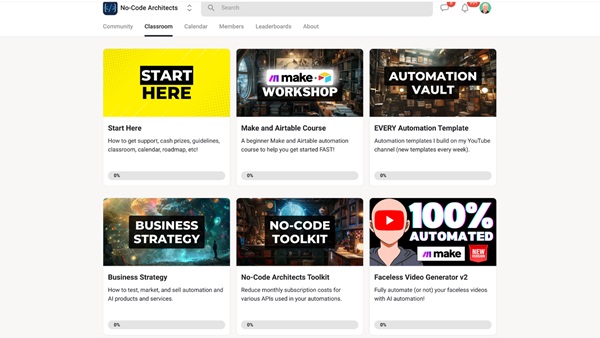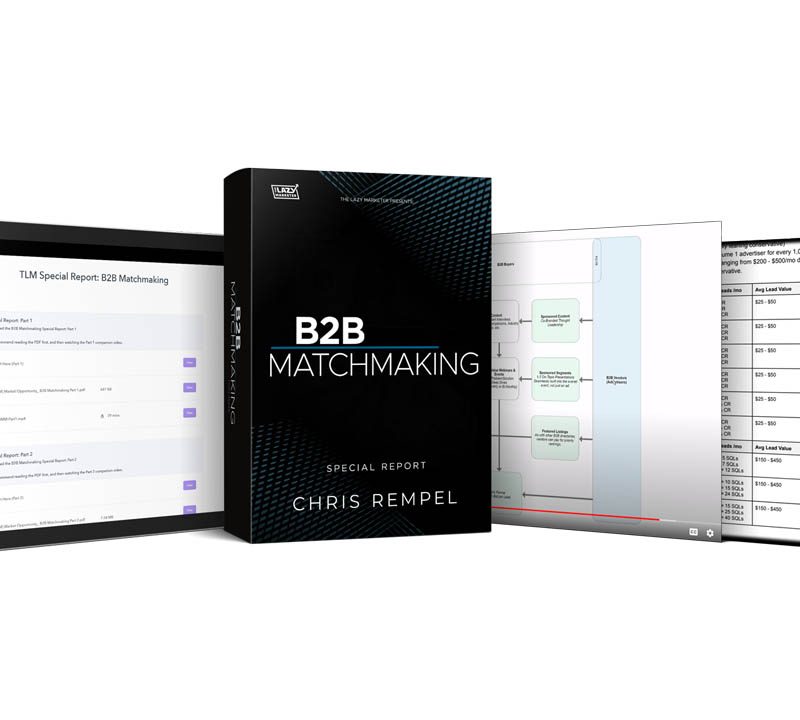Stephen G. Pope – Automation No Code Architects [January 2025]
$49.00
Discount 20% if your total cart over $150
- Satisfaction Guaranteed
- Fast and forever download link
- Secure Payments
- Reupload FREE
Description
Proof of the course:


The modern business landscape demands agility and efficiency. A code architect used to be confined to only the tech world, but businesses today are seeking individuals who can orchestrate digital transformation, leveraging cutting-edge technologies like AI and no-code platforms to build scalable solutions without being slowed by traditional coding bottlenecks.
Code Architect
The traditional image of a code architect often conjures up a figure deeply immersed in lines of complex code, designing the intricate blueprints of software systems. While that image still holds true in many contexts, the definition of a code architect is rapidly evolving. Today, it’s about designing solutions, regardless of how they are built. It’s about understanding the business needs, identifying the right tools – be they code-based or no code – and orchestrating their implementation for maximum impact.
The Evolving Role of the Architect
The rise of no-code and low-code platforms is democratizing software development, allowing individuals with limited or no coding experience to create sophisticated applications and automate complex processes. This shift necessitates a new breed of architect – one who is fluent in the language of both traditional code and these emerging platforms, capable of choosing the best tool for the job. The modern architect is a master orchestrator, blending code, no-code, and AI to craft elegant solutions.
This evolution also demands a shift in skillset. While technical proficiency remains crucial, the modern code architect must also possess strong analytical and problem-solving skills, a deep understanding of business processes, and the ability to communicate effectively with both technical and non-technical stakeholders. They need to understand the entire business ecosystem and design solutions that seamlessly integrate with existing systems. It’s no longer just about building the what, but about why and how it benefits the business.
The Code Architect as a Business Strategist
The power of a code architect lies not just in technical prowess, but in understanding how technology can drive business growth. They are strategists, identifying opportunities for automation, process optimization, and new product development. They are able to translate business requirements into technical specifications, and then guide the implementation of those specifications using the most efficient and effective tools available. This strategic vision is what sets them apart from traditional developers who are focused primarily on code.
For example, a code architect at a marketing agency might identify that creating personalized content at scale is a major bottleneck. Instead of relying on manual processes or expensive custom software, they could leverage Airtable automations combined with AI-powered content generation tools to streamline the process, resulting in increased efficiency and improved ROI for clients. This type of strategic thinking is invaluable in today’s competitive landscape. The code architect has moved beyond just developing softwares, and now help shape the future of the company.
Embracing Continuous Learning
The technology landscape is constantly evolving, and a code architect must be committed to continuous learning. This means staying up-to-date with the latest trends in AI, no-code, and other emerging technologies, as well as continually honing their skills in areas such as project management, business analysis, and communication. The ability to adapt to new technologies and methodologies is essential for success in this dynamic field.
Staying at the forefront, it can be as simple as reading industry blog posts and testing new applications. Being a code architect also means attending industry conferences and workshops, or actively participating in online communities. The key is to cultivate a mindset of curiosity and a willingness to experiment with new approaches. If all these approaches still don’t get the code architect the right resources to start from, finding a mentor could also be a great idea.
No Code Architects
The concept of no code architects represents a significant paradigm shift in the software development landscape. These individuals are not necessarily traditional programmers, but rather visionaries who can design and implement complex solutions using no-code or low-code platforms. They democratize software development, empowering businesses to build applications faster, cheaper, and with greater agility. The “No-Code Architects” community perfectly encapsulates this trend.
Empowering the Citizen Developer
No code architects are the champions of “citizen developers,” empowering individuals with domain expertise but limited coding skills to create their own applications and automate workflows. They act as facilitators, providing guidance, training, and support to these citizen developers, ensuring that solutions are aligned with business needs and adhere to best practices. In essence, they are building a new generation of tech-savvy professionals who can drive innovation from within.
This empowerment is critical for organizations that want to embrace digital transformation at scale. By enabling employees to build their own solutions, businesses can unlock a wealth of creativity and innovation that might otherwise be untapped. The no code architects act as the catalyst for this transformation, fostering a culture of experimentation and continuous improvement.
Leveraging the Power of No-Code Platforms
The no code architects are proficient in a wide range of no-code and low-code platforms, such as Airtable, Bubble, Webflow, and Zapier. They understand the strengths and weaknesses of each platform, and can choose the right tool for the specific task at hand. They are not simply users of these platforms, but rather experts who can push them to their limits, crafting sophisticated solutions that rival those built with traditional code.
The “No-Code Architects” community itself embodies this expertise, offering training courses on platforms like Make.com and Airtable, as well as providing pre-built automation templates that can be customized for specific business needs. This knowledge sharing is crucial for accelerating the adoption of no-code and empowering businesses to realize its full potential. The community’s promise to solve “100% of your tech issues (guaranteed)” is a bold statement that underscores the confidence they have in their no-code capabilities.
The No-Code Architect’s Toolkit
The toolkit of a no code architect goes beyond just the no-code platforms themselves. It includes a deep understanding of business processes, data modeling, user experience design, and integration strategies. They need to be able to translate business requirements into visual workflows, design intuitive interfaces, and ensure that data flows seamlessly between different applications. The toolkit has been built to eliminate $100s in monthly API subscriptions.
Furthermore, no code architects must have a strong understanding of AI and automation. The “No-Code Architects” community emphasizes leveraging AI for content creation and business automation, highlighting the importance of these technologies in driving growth and efficiency. From automating content creation to predicting customer behavior, AI is a powerful tool in the hands of a skilled no-code professional.
No SGP
The term “no SGP” is a bit ambiguous without further context. It could potentially refer to a desire to avoid Single-Point Guarantee architectures, a practice common in system design aiming for high availability, redundancy, and preventing single points of failure. However, in the context of this document, it likely pertains to the emphasis of the No Code Architects community on non-technical professionals being able to create architectures. Single-Point Guarantees are a technical promise, and a core feature of no-code options is the ability to remove the complexity.
Redundancy and Resilience
In system design, avoiding no SGP is crucial for ensuring redundancy and resilience. A single point of failure can bring down an entire system, causing downtime, data loss, and financial repercussions. No SGP architectures mitigate this risk by distributing critical functions across multiple components, so that if one component fails, others can take over seamlessly.
In the context of no code development, this translates to building applications that are robust and scalable. While many no-code platforms offer built-in redundancy and high availability, it’s still important to design solutions that can handle unexpected events. This might involve using multiple data sources, implementing error handling mechanisms, or leveraging serverless functions to offload computationally intensive tasks.
It is also important to have backup. For instance, a business relying heavily on Airtable for its CRM could mitigate the risk of data loss by regularly backing up its data to a separate database. It’s about anticipating potential problems and building in safeguards to prevent them from derailing the entire system. If a business is planning to go down, there is an important plan to make sure it gets back on track without it happening.
Distributed Systems and Microservices
Distributed systems and microservices are architectural patterns that inherently avoid no SGP. By breaking down an application into smaller, independent services that communicate with each other over a network, these architectures create a more resilient and scalable system. If one microservice fails, the others can continue to operate, minimizing the impact on the overall application.
No code platforms can be used to build individual microservices, or to orchestrate the interactions between multiple microservices. For example, Zapier can be used to connect different applications and services, enabling them to exchange data and trigger actions based on specific events. This allows no code architects to build complex, distributed systems without writing a single line of traditional code.
A no code architect might leverage Retool to build custom interfaces for interacting with microservices, or use IFTTT to create simple integrations between different platforms. This is all about leveraging the right tools to create a more robust and scalable system. By applying the principles of distributed systems to no code development, businesses can build applications that are highly resilient and adaptable to changing needs.
The Importance of Testing and Monitoring
Even with a no SGP architecture, it’s crucial to implement thorough testing and monitoring procedures. This involves regularly testing the system to identify potential weaknesses, and constantly monitoring its performance to detect and address any issues that might arise. Without testing and monitoring, even the most well-designed architecture can be vulnerable to unexpected failures. That is the importance of business and contact strategy that No-Code Architects mentioned.
The “No-Code Architects” community emphasizes the importance of daily tech support calls, highlighting the need for ongoing maintenance and troubleshooting. This is where the expertise of a no code architect becomes invaluable. They can leverage monitoring tools to track key performance metrics, and use their knowledge of the system to diagnose and resolve any problems quickly and efficiently.
A well-defined testing and monitoring strategy is essential for ensuring the long-term reliability of any system, regardless of whether it’s built with code or no code. It’s all about proactive measures and continuously improving the system to minimize the risk of failures and ensure that it continues to meet the needs of the business.
Airtable Consultants
Airtable consultants are specialists who help businesses leverage the full potential of Airtable, a powerful and versatile no-code platform that combines the features of a spreadsheet and a database. They can assist with everything from designing custom databases to automating complex workflows, enabling businesses to streamline their operations and gain valuable insights from their data.
Database Design and Implementation
One of the primary roles of Airtable consultants is to design and implement custom databases that meet the specific needs of a business. This involves understanding the business’s data requirements, creating a data model that accurately reflects those requirements, and then building the database in Airtable, complete with appropriate fields, data types, and relationships.
Airtable consultants have years of data modeling experience, as well as experience building scalable, reusable databases. They possess the ability to design efficient database structures, implement data validation rules, and optimize database performance for large datasets. This deep level of expertise is vital for businesses that want to leverage Airtable as a robust data management solution.
An Airtable consultant might work with a marketing agency to design a database that tracks leads, manages campaigns, and analyzes results. Or, they could work with a manufacturing company to build a database that tracks inventory, manages orders, and schedules production. It is about understanding how they can improve the business of a company as a consultant.
Automation and Integration
In addition to database design, Airtable consultants can also help businesses automate their workflows and integrate Airtable with other applications. This involves using Airtable’s built-in automation features, as well as integrating with third-party services like Zapier and Integromat, to create automated processes that eliminate manual tasks and improve efficiency. These integrations are the toolkits that allows for the elimination of monthly API subscriptions.
Airtable consultants have a deep understanding of automation principles and integration techniques. They can automate repetitive tasks like data entry, email marketing, and social media posting. The “No-Code Architects” community’s emphasis new weekly automation templates further underscores the growing demand for these automated solution.
An Airtable consultant might automate the process of creating invoices from Airtable data, or they could integrate Airtable with a project management tool to automatically update task statuses. All this will help saves time and reduces the risk of human error. No amount of automation will be useless.
Training and Support
Finally, Airtable consultants can provide training and support to businesses that want to learn how to use Airtable more effectively. This can involve one-on-one training sessions, group workshops, or the creation of custom training materials. The goal is to empower businesses to become self-sufficient in using Airtable, so they can continue to improve their operations and gain valuable insights from their data.
Airtable consultants are able to create customized training programs that are tailored to the specific needs of the business. They can also provide ongoing support to answer questions, troubleshoot problems, and help businesses stay up-to-date with the latest features and capabilities of Airtable.
An Airtable consultant might provide training to a sales team on how to use Airtable to track leads and manage customer relationships. Or, they could provide support to a project management team on how to use Airtable to track tasks and collaborate on projects. The key is to empower businesses to leverage Airtable to its full potential.
Spg Architects
The concept of SPG Architects is a less established term in the industry, but it could possibly refer to Solution Provider Group Architects, Single Point of Contact Architects, or even architects specializing in Specific Geographic Places. Without a specific definition, we can interpret SPG Architects as architects who focus on providing comprehensive solutions, especially within constraints like geographical limitations. Assuming a focus on comprehensive solutions, SPG Architects need to know different types of business.
Holistic Solution Design
SPG Architects focus on providing comprehensive solutions that address all aspects of a client’s needs. This involves understanding the client’s business goals, identifying pain points, and then designing a solution that integrates seamlessly with existing systems and processes. They bring a holistic perspective to problem-solving, considering not just the technical aspects but also the business, operational, and human factors.
SPG Architects have experience in various domains, as well as knowing different best solution design. They are able to bridge the gap between business and technology, translating business requirements into technical specifications, and then guiding the implementation of those specifications. It’s about crafting solutions that are not only technically sound but also aligned with the overall business strategy.
An SPG architect might work with a healthcare provider to design a patient management system that integrates with electronic health records, billing systems, and appointment scheduling software. This might include improving patient experience. Or, they could work with a retail chain to design an inventory management system that integrates with point-of-sale systems, warehouse management systems, and e-commerce platforms. It’s about solving complex business challenges with comprehensive, integrated solutions.
Addressing Specific Constraints
SPG Architects also excel at working within specific constraints, such as budget limitations, regulatory requirements, or geographical limitations. They are masters of resource optimization, finding creative ways to deliver high-quality solutions that meet the client’s needs while staying within the specified constraints. This requires a deep understanding of the available resources and a keen ability to prioritize and make trade-offs.
SPG Architects are able to identify cost-effective solutions, navigate complex regulatory landscapes. For the No-Code Architects, they understand the requirements around Tech Support and how to deliver support at a low cost to themselves and their customers.
An SPG architect working with a small business might design a cloud-based solution that leverages open-source software and free resources. They might also choose a no-code solution to speed up development and reduce costs. It’s about finding innovative ways to deliver value within the constraints of the project.
Long-Term Partnerships
SPG Architects often build long-term partnerships with their clients, providing ongoing support and guidance as their needs evolve. They are not simply hired to design a solution and then disappear; but they also support the client team on how to use the solutions so that they don’t dissapear. Over time, they take a personal initiative.
SPG Architects can help the clients so that they stay up-to-date with the solutions or technology. They might assist with upgrades, migrations, or expansion projects. It’s about being a trusted advisor and a strategic partner. No Code Architects also have a guaranteed tech support, where problems are solved 100% or give a refund.
An SPG architect might work with a growing company, creating new features and capabilities as the company expands. Or, they could work with a non-profit organization, providing ongoing support and training to help them achieve their mission. The key is to build a relationship of trust and collaboration, so that the client feels confident that they have a trusted partner by their side.
Airtable Templates
Airtable templates are pre-built database structures and workflows that can be used as a starting point for building custom applications in Airtable. They provide a quick and easy way to get started with Airtable, and can save a significant amount of time and effort compared to building a database from scratch.
Accelerating Application Development
Airtable templates can significantly accelerate the application development process. Instead of starting with a blank slate, users can choose a template that aligns with their needs and then customize it to fit their specific requirements. This can save hours or even days of work, allowing businesses to get up and running with Airtable much faster.
Airtable templates provide an outline to build their own custom workflows. They might also provide a framework for data collection, so that users can quickly start gathering information. It’s about providing a jumpstart to the application development process. Since No-Code Architects also offers advanced content automation, suggesting a strong focus on simplifying work tasks using AI.
A marketing team could use an Airtable template to create a project management system. Or, a sales team could use a template to create a lead tracking system. The key is to choose templates that have pre-built workflows.
Learning Best Practices
Airtable templates can also be a valuable resource for learning best practices in database design and workflow automation. By examining how these are structured, users can gain insights into effective data modeling techniques and efficient automation strategies. In essence, they serve as educational tools, helping users to improve their skills and build better applications.
Airtable templates comes with lots of example scenarios, so users can test out different features. It’s about helping people learn more about the solution. Another offer of the No-Code Architects provide comprehensive resources and training regarding Airtable, further validates this value.
A new Airtable user can get from studying the structure of the templates. Or, a marketing professional can discover how sales can connect them to generate campaigns. The key is to see them and learn how to make new ones.
Customization and Extensibility
While Airtable templates provide a great starting point, they are also fully customizable and extensible. Users can easily modify the templates to add new fields, change data types, create new views, and add custom automations. This flexibility allows businesses to create applications that are tailored to their specific needs, while still leveraging the benefits of a pre-built structure.
Airtable templates gives users the right to create new fields that the templates did not have. The users can design the Airtable templates to suit their own needs. The option to personalize Airtable templates is a key feature.
A sales team using an Airtable template of their own could add new features to keep track of sales lead. Or, a developer can add a new automation that sends out new promotional material. It’s about making the product as simple as possible.
Airtable Automations
Airtable automations are a powerful feature that allows users to automate repetitive tasks and workflows within Airtable. By setting up triggers and actions, businesses can streamline their processes, reduce manual effort, and improve efficiency.
Streamlining Repetitive Tasks
One of the primary benefits of Airtable automations is the ability to streamline repetitive tasks. Instead of manually performing the same actions over and over again, users can set up automations to handle these tasks automatically. This frees up time and resources, allowing employees to focus on more strategic and value-added activities.
Airtable automations give users the ability to generate a automated email chain once a specific set of rules are set. This has a high improvement amount for workers and is especially true with the advent of advanced content creation with AIs.
A marketing team could automate the sending of follow-up emails to new leads. Or, a sales team could automate the creation of tasks in a project management system when a new deal is closed. The key is to identify repetitive tasks and then use Airtable automations to handle them automatically. Automating your tasks helps your business thrive more efficiently.
Improving Data Consistency
Airtable automations can also help improve data consistency. By setting up rules that automatically validate data, users can ensure that inputs are accurate and consistent. This reduces the risk of errors and makes it easier to analyze data and gain valuable insights.
Airtable automations creates a clear outline for users, helping to ensure that they are fulfilling the tasks. This provides a consistency in what would otherwise be potentially missed steps. The daily calls and accountability sessions facilitated by the “No-Code Architects” community are great ways to improve data consistency and collaboration!
A marketing team could automate the validation of email addresses that would otherwise cause mistakes. Or, a sales team could automate the validation of client numbers and prevent losses from occurring. It’s about ensuring that data is accurate and consistent across the system.
Enhancing Collaboration
Finally, Airtable automations can enhance collaboration by automatically notifying team members of important events or updates. By setting up triggers that send notifications, users can ensure that everyone is kept in the loop and that no important information is missed. This improves communication and collaboration, leading to more effective team work.
Airtable automations can give key workers from each group, and it will inform the other workers so that communication is as direct as possible. This clear outline makes it easier to collaborate in any tasks.
A marketing team that sends a message to workers everytime a lead gets close to closing. Or, a sales team that sends a message to everyone once each deal is made that will inspire the work team. The key is to keep workers and teams connected to promote the efficiency of the team collaboration.
Conclusion
The evolving landscape of technology demands a new breed of professional – the code architect who can seamlessly blend traditional coding with no-code and AI solutions. The no code architects are at the forefront of this revolution, empowering businesses to build applications faster, cheaper, and with greater agility. Resources such as Airtable consultants, a solution to no sgp(single point of failures), and an understanding of how to implement airtable templates and airtable automations is essential to the craft.
Communities like the No Code Architects community provide valuable resources, training, and support. As businesses continue to embrace digital transformation, the demand for these innovative professionals will only continue to grow. By embracing continuous learning, developing a strategic mindset, and mastering the tools of the trade, aspiring code architects can play a vital role in shaping the future of business.





